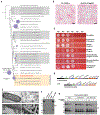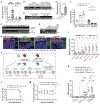A host-adapted auxotrophic gut symbiont induces mucosal immunodeficiency
- PMID: 39325906
- PMCID: PMC12486176
- DOI: 10.1126/science.adk2536
A host-adapted auxotrophic gut symbiont induces mucosal immunodeficiency
Abstract
Harnessing the microbiome to benefit human health requires an initial step in determining the identity and function of causative microorganisms that affect specific host physiological functions. We show a functional screen of the bacterial microbiota from mice with low intestinal immunoglobulin A (IgA) levels; we identified a Gram-negative bacterium, proposed as Tomasiella immunophila, that induces and degrades IgA in the mouse intestine. Mice harboring T. immunophila are susceptible to infections and show poor mucosal repair. T. immunophila is auxotrophic for the bacterial cell wall amino sugar N-acetylmuramic acid. It delivers immunoglobulin-degrading proteases into outer membrane vesicles that preferentially degrade rodent antibodies with kappa but not lambda light chains. This work indicates a role for symbionts in immunodeficiency, which might be applicable to human disease.
Conflict of interest statement
Figures






Comment in
-
Microbial hoolIgAn dismantles gut defenses.Science. 2024 Sep 27;385(6716):1418-1420. doi: 10.1126/science.ads2152. Epub 2024 Sep 26. Science. 2024. PMID: 39325916
References
Publication types
MeSH terms
Substances
Grants and funding
LinkOut - more resources
Full Text Sources
Miscellaneous

